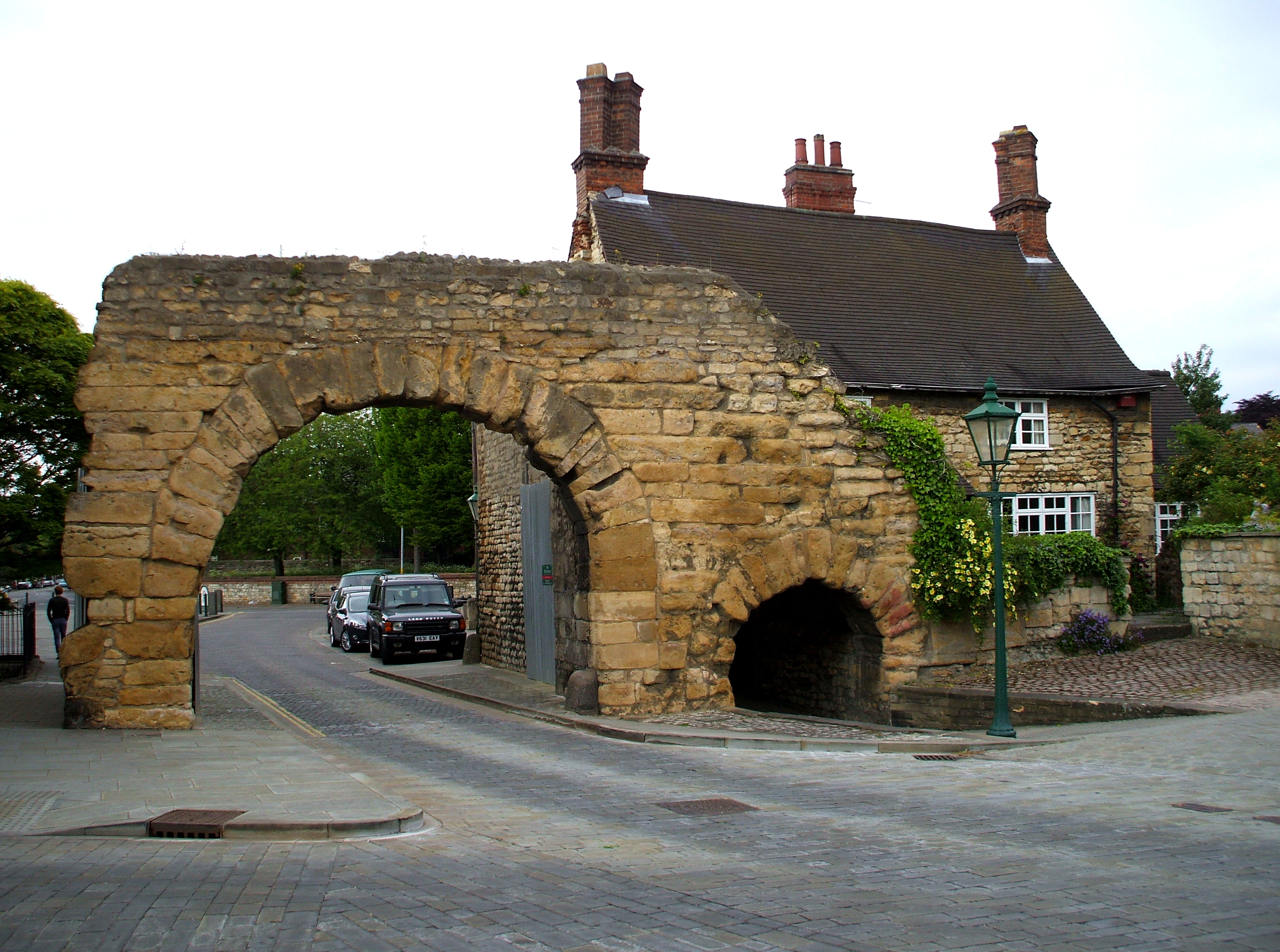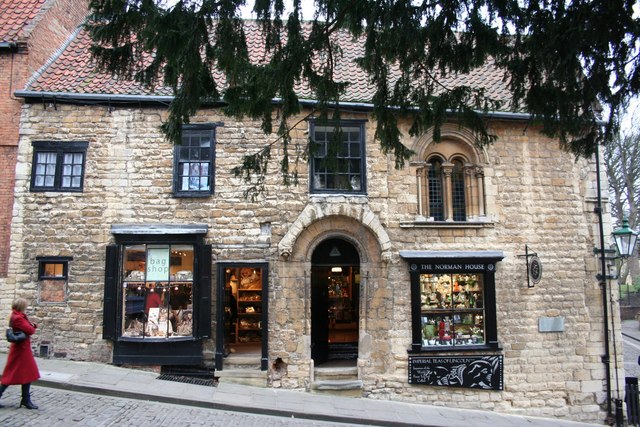|
John Of Gaunt’s Palace, Lincoln
John of Gaunt's Palace was a late 14th-century merchant's house which stood in the lower part of Lincoln High Street, opposite the St Mary Guildhall. It was progressively demolished from the late 18th century until the 1960s. The very fine oriel window from the building has been preserved in the gatehouse of Lincoln Castle. History The palace was initially built by a member of the wealthy Sutton family of Lincoln merchants in the latter years of the 14th century, on land immediately to the north of St Andrew's church. Research into the history of the building by Sir Francis Hill greatly clarified its early ownership. More recently the study of early drawings and maps by David Stocker has made it possible to reconstruct the layout of the building. Stocker suggested the building was probably built by John of Gaunt's vassal John Sutton, a wealthy merchant and mayor of Lincoln in 1386. However S. H. Rigby has made out a case that the palace was originally built by Robert Sutton ... [...More Info...] [...Related Items...] OR: [Wikipedia] [Google] [Baidu] |
Lincoln, England
Lincoln () is a cathedral city and non-metropolitan district, district in Lincolnshire, England, of which it is the county town. In the 2021 Census, the city's district had a population of 103,813. The 2021 census gave the Lincoln Urban Area, urban area of Lincoln, including Bracebridge Heath, North Hykeham, South Hykeham and Waddington, Lincolnshire, Waddington, a recorded population of 127,540. Roman Britain, Roman ''Lindum Colonia'' developed from an Iron Age settlement of Celtic Britons, Britons on the River Witham, near the Fosse Way road. Over time its name was shortened to Lincoln, after successive settlements, including by Anglo-Saxons and Danes (tribe), Danes. Landmarks include Lincoln Cathedral (English Gothic architecture; for over 200 years the world's tallest building) and the 11th-century Norman architecture, Norman Lincoln Castle. The city hosts the University of Lincoln, Bishop Grosseteste University, Lincoln City F.C. and Lincoln United F.C. Lincoln is the large ... [...More Info...] [...Related Items...] OR: [Wikipedia] [Google] [Baidu] |
Spandrels
A spandrel is a roughly triangular space, usually found in pairs, between the top of an arch and a rectangular frame, between the tops of two adjacent arches, or one of the four spaces between a circle within a square. They are frequently filled with decorative elements. Meaning There are four or five accepted and cognate meanings of the term ''spandrel'' in architectural and art history, mostly relating to the space between a curved figure and a rectangular boundary – such as the space between the curve of an arch and a rectilinear bounding moulding, or the wallspace bounded by adjacent arches in an arcade and the stringcourse or moulding above them, or the space between the central medallion of a carpet and its rectangular corners, or the space between the circular face of a clock and the corners of the square revealed by its hood. Also included is the space under a flight of stairs, if it is not occupied by another flight of stairs. In a building with more than one floo ... [...More Info...] [...Related Items...] OR: [Wikipedia] [Google] [Baidu] |
Ruins In Lincolnshire
Ruins () are the remains of a civilization's architecture. The term refers to formerly intact structures that have fallen into a state of partial or total disrepair over time due to a variety of factors, such as lack of maintenance, deliberate destruction by humans, or uncontrollable destruction by natural phenomena. The most common root causes that yield ruins in their wake are natural disasters, armed conflict, and population decline, with many structures becoming progressively derelict over time due to long-term weathering and scavenging. There are famous ruins all over the world, with notable sites originating from ancient China, the Indus Valley, ancient Iran, ancient Israel and Judea, ancient Iraq, ancient Greece, ancient Egypt, ancient Yemen, Roman, ancient India sites throughout the Mediterranean Basin, and Incan and Mayan sites in the Americas. Ruins are of great importance to historians, archaeologists and anthropologists, whether they were once individual fortifi ... [...More Info...] [...Related Items...] OR: [Wikipedia] [Google] [Baidu] |
Jew's Court
Jews' Court is a Jewish museum and Liberal Jewish congregation and synagogue, located on Steep Hill in Lincoln, Lincolnshire, England, in the United Kingdom. The building was listed as a Grade I building in 1953 and houses the headquarters of the Society for Lincolnshire History and Archaeology. History Jews' Court is located immediately above Jew's House on Steep Hill. The three-storeyed stone building dates from but was altered in the 18th century and the windows were replaced in the early-19th and 20th centuries. The Jews' Court may contain some late medieval stonework but a recent architectural survey has shown that there is very little medieval stonework above basement level in the existing building. Historian Cecil Roth believed it to be the site of a medieval synagogue. Documentary evidence of 1290 when the Jewish community of Lincoln was expelled shows that the Jews' Court has always been divided into two houses, and a charter of 1316 mentions that a Jewish ''sco ... [...More Info...] [...Related Items...] OR: [Wikipedia] [Google] [Baidu] |
Whitefriars, 333 High Street, Lincoln
Whitefriar or Akrill's Court is a 16th century timber-framed building in Lincoln. It now has a late 20th century shop front, but the timber-framed building survives with the southern front facing the narrow Akrill’s passage, on the east side of the High Street and just to the south of the railway crossing. History Surprisingly little is known about this building. The name Akrill refers to a baker who owned the property in the early part of the 19th century. Padley, who made scaled drawings of the buildings in 1851, said that traditionally it was thought to be part of the White or Carmelite Friary in Lincoln. Adjacent to it at the east end was a small stone building with a Norman arch. As the Carmelite friary has now been shown by archaeological excavation to have been under St Mark's Station, on the opposite side of the High Street, it is unlikely that the building was associated with the friary. It has been alternatively suggested that the Whitefriars was the half-timbered vic ... [...More Info...] [...Related Items...] OR: [Wikipedia] [Google] [Baidu] |
Bang And Olufsen
Bang & Olufsen (B&O) is a Danish high-end consumer electronics company that designs and manufactures audio products, television sets, and telephones, originally from Denmark, founded in 1925 by Peter Bang and Svend Olufsen, who designed a radio to work with alternating current, a product of significance at a time when most radios were still running on batteries. History Early history Peter Bang (1900–1957), son of Camillo Bang, a successful Danish businessman, showed great interest in radio technology from an early age. After graduating as an engineer in 1924, he spent six months working in a radio factory in the USA. When he returned to Denmark, he collaborated with his friend Svend Olufsen (1897–1949), whose parents made the attic of their manor house in Struer in Jutland available for experiments. When they officially opened their business in 1925, Bang focused on the technology while Olufsen was dealing with business. There were a number of successful developments i ... [...More Info...] [...Related Items...] OR: [Wikipedia] [Google] [Baidu] |
Romanesque Architecture
Romanesque architecture is an architectural style of medieval Europe that was predominant in the 11th and 12th centuries. The style eventually developed into the Gothic style with the shape of the arches providing a simple distinction: the Romanesque is characterized by semicircular arches, while the Gothic is marked by the pointed arches. The Romanesque emerged nearly simultaneously in multiple countries of Western Europe; its examples can be found across the continent, making it the first pan-European architectural style since Imperial Roman architecture. Similarly to Gothic, the name of the style was transferred onto the contemporary Romanesque art. Combining features of ancient Roman and Byzantine buildings and other local traditions, Romanesque architecture is known by its massive quality, thick walls, round arches, sturdy pillars, barrel vaults, large towers and decorative arcading. Each building has clearly defined forms, frequently of very regular, symmetrical ... [...More Info...] [...Related Items...] OR: [Wikipedia] [Google] [Baidu] |
Grade II*
In the United Kingdom, a listed building is a structure of particular architectural or historic interest deserving of special protection. Such buildings are placed on one of the four statutory lists maintained by Historic England in England, Historic Environment Scotland in Scotland, in Wales, and the Historic Environment Division of the Department for Communities in Northern Ireland. The classification schemes differ between England and Wales, Scotland, and Northern Ireland (see sections below). The term has also been used in the Republic of Ireland, where buildings are protected under the Planning and Development Act 2000, although the statutory term in Ireland is " protected structure". A listed building may not be demolished, extended, or altered without permission from the local planning authority, which typically consults the relevant central government agency. In England and Wales, a national amenity society must be notified of any work to be done on a listed building ... [...More Info...] [...Related Items...] OR: [Wikipedia] [Google] [Baidu] |
Norman House
Norman House on Steep Hill, Lincoln, England is a historic building and an example of Norman architecture#Domestic architecture, Norman domestic architecture. The building is at 46–47 Steep Hill and 7 Christ's Hospital Terrace. The architectural evidence suggests a date between 1170 and 1180. The building was known for many years as "Aaron the Jew's House", and appears as such in many references, as it was thought to be the former residence of Aaron of Lincoln (c.1125–1186), although this is now considered incorrect. The building has been a shop for many years, and is currently home to a tea importers. It has been designated a Grade I listed building by English Heritage. See also *Jew's House *Jew's Court *John of Gaunt's Palace, Lincoln *St Mary's Guildhall, Lincoln References External links The present tenant Buildings and structures completed in 1180 History of Lincolnshire Norman architecture in England Buildings and structures in Lincoln, England Grade I liste ... [...More Info...] [...Related Items...] OR: [Wikipedia] [Google] [Baidu] |
Jew's House
The Jew's House is one of the earliest extant town houses in England, estimated to have been built around 1170. It is situated on Steep Hill in Lincoln, immediately below Jew's Court. The house has traditionally been associated with the thriving Jewish community in Medieval Lincoln. Antisemitic hysteria was stoked by a notorious 1255 blood libel alleging that the mysterious death of a Christian child, known as Little Saint Hugh of Lincoln, was the result of him allegedly being kidnapped and ritually killed by Jews. In 1290, the entire Jewish community was expelled from England by Edward I, and the Jew's House is said to have been seized from a Jewish owner. The building has remained continuously occupied to the present day. Since about 1973 it has been used as a restaurant A restaurant is an establishment that prepares and serves food and drinks to customers. Meals are generally served and eaten on the premises, but many restaurants also offer take-out and Delivery (commerce ... [...More Info...] [...Related Items...] OR: [Wikipedia] [Google] [Baidu] |
Artisan Mannerism
The Caroline era is the period in English and Scottish history named for the 24-year reign of Charles I (1625–1649). The term is derived from ''Carolus'', Latin for Charles. The Caroline era followed the Jacobean era, the reign of Charles's father James I & VI (1603–1625), overlapped with the English Civil War (1642–1651), and was followed by the English Interregnum until The Restoration in 1660. It should not be confused with the Carolean era, which refers to the reign of Charles I's son King Charles II. The Caroline era was dominated by growing religious, political, and social discord between the King and his supporters, termed the Royalist party, and the Parliamentarian opposition that evolved in response to particular aspects of Charles's rule. While the Thirty Years' War was raging in continental Europe, Britain had an uneasy peace, growing more restless as the civil conflict between the King and the supporters of Parliament worsened. Despite the friction betwee ... [...More Info...] [...Related Items...] OR: [Wikipedia] [Google] [Baidu] |
Colonel Bromhead's House
Colonel ( ; abbreviated as Col., Col, or COL) is a senior military Officer (armed forces), officer rank used in many countries. It is also used in some police forces and paramilitary organizations. In the 17th, 18th, and 19th centuries, a colonel was typically in charge of a regiment in an army. Modern usage varies greatly, and in some cases, the term is used as an Colonel (title), honorific title that may have no direct relationship to military. In some smaller military forces, such as those of Monaco or the Holy See, Vatican, colonel is the highest Military rank, rank. Equivalent naval ranks may be called Captain (naval), captain or ship-of-the-line captain. In the Commonwealth of Nations, Commonwealth's air force ranking system, the equivalent rank is group captain. History and origins By the end of the late medieval period, a group of "companies" was referred to as a "column" of an army. According to Raymond Oliver, , the Spanish began explicitly reorganizing part of thei ... [...More Info...] [...Related Items...] OR: [Wikipedia] [Google] [Baidu] |








